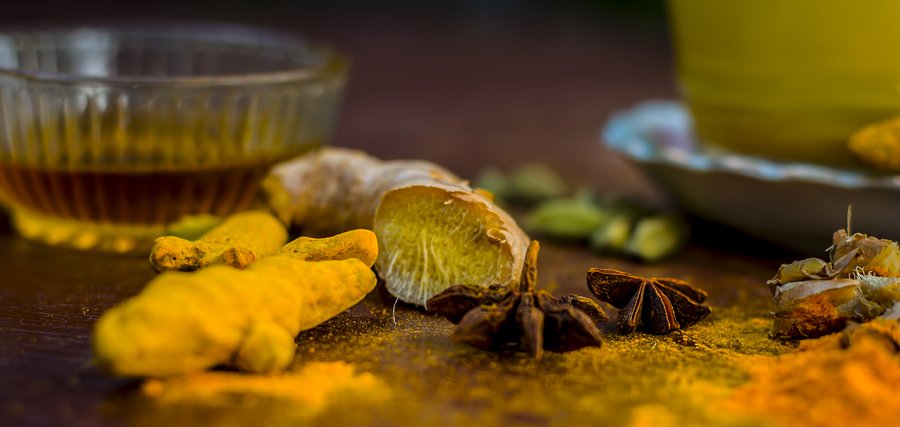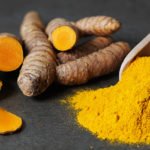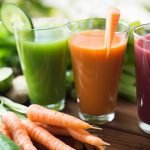If you grew up back in the days before Starbucks became a household name, your mother’s spice cabinet probably consisted of salt, pepper, paprika, onion powder, oregano, basil, and maybe Accent. But then came the food revolution with ethnic restaurants popping up in major cities everywhere, and suddenly so-called exotic spices like curry, cardamom, ginger, and turmeric became must-haves for the good cook’s kitchen. The irony is that although these flavorings didn’t make it to the average US table until a few decades ago, they were in wide use in India as long ago as 2000 BC.1 Banarjee, Soity. “Cooking the world’s oldest known curry.” 22 June 2016. BBC. 8 March 2018. http://www.bbc.com/news/world-asia-india-36415079 In fact, according to a BBC series, India on a Plate, archaeologists found traces of eggplant curry in 4000-year-old artifacts near Delhi, India, meaning that the baingan bharta you ate last night at the India Palace Restaurant might be almost the same meal as Bombay residents enjoyed during the late Bronze Age.
Why blend turmeric, ginger, and cardamom together in one blog (or pot, for that matter)? Because they’re related. All are derived from flowering plants in the ginger family (technical name Zingiberaceae, if you want to impress friends) growing in the tropics and subtropics. The family resemblance is clear if you place ginger and turmeric side by side.2“Zingaberaceae.” Encyclopedia Britannica. 8 March 2018. http://www.britannica.com/plant/Zingiberaceae Turmeric root looks just like ginger root, with jaundice. Cardamom comes from the seeds of a different member of the Zingiberaceae family. The three blend particularly well in cooking, creating aromatic dishes that some find nearly ecstasy-producing (see The Hundred Foot Journey or The Mistress of Spices or Today’s Special), but also, all are imbued with considerable healing properties.
Turmeric contains the bioactive component “Curcumin,” which, among other things, aids in reducing inflammation. In fact, studies have found it to be as effective as prescription anti-inflammatory medication, making it particularly promising for use in conditions like inflammatory bowel disease, pancreatitis, and arthritis.3 Jurenka, JS. “Anti-inflammatory properties of curcumina major constituent of Curcuma longa: a review of preclinical and clinical research.”14 June 2009. Alternative Medical Review. 9 March 2018. http://www.ncbi.nlm.nih.gov/pubmed/19594223 There’s a catch, though. First, the curcumin content in turmeric is only about three percent, so eating raw turmeric root probably won’t work, at least according to some experts.4 Gunnars, Kris. “10 Proven Health Benefits of Turmeric and Curcumin.” Healthline Newsletter. 9 March 2018. http://www.healthline.com/nutrition/top-10-evidence-based-health-benefits-of-turmeric Instead, they say, you need to take curcumin extract. And, curcumin isn’t easily bioavailable (although it’s much more so as a liquid extract), so it needs to be combined with something that allows the system to absorb it. Black pepper or Bioperin® (a black pepper extract) seems to do the trick, so if you take a curcumin supplement make sure it has black pepper added or swallow a peppercorn along with the pill.
On the other hand, turmeric has other components and some researchers believe that the benefits of turmeric extend far beyond the curcumin content. They don’t know for sure, though, because studies to date have mostly focused on curcumin.
In any event, curcumin—and research seems to indicate your body definitely can absorb it—offers plenty of other benefits. The most notable is its use as an anti-carcinogen. As we’ve written before, “Studies have shown that [curcumin] can inhibit colon cancer cells by 96% in a matter of hours. It also appears to have great potential in countering the effects of prostate cancer and breast cancer.” A 2015 study published in Nutrition Review found that curcumin weakens or even disables certain types of cell signaling pathways, inhibiting tumor growth.5 Devassy, JG et al. “Curcumin and cancer: Barriers to obtaining a health claim.” 7 March 2015. Nutrition Review. 9 March 2018. http://www.ncbi.nlm.nih.gov/pubmed/26024538 Another 2015 study found that curcumin combined with alpha-tomatine, which is found in tomatoes, can stop the growth of prostate cancer cells and perhaps even kill existing cells.6 Scaccia, Annamyra. Earlier studies also confirmed curcumin/tumeric’s usefulness in combatting prostate cancer, which is why it’s included in Jon Barron’s Men’s Formula.
Plus, curcumin protects cancer patients undergoing radiation treatment. One 2016 study found it enhances the effectiveness of radiation while keeping antioxidant levels high, and another found that it protects patients from urinary tract problems that may accompany radiation.
Recent studies highlight a few of the other wonders of curcumin. Scientists at UCLA recently completed a study that found elderly patients taking curcumin over 18 months experienced a 28 percent boost in memory, while the control subjects who didn’t take the supplement did not.7“Curcumin could provide meaningful cognitive benefit, study shows.” 23 January 2018. Medical Life Sciences News. 9 March 2018. http://www.news-medical.net/news/20180123/Curcumin-could-provide-meaningful-cognitive-benefits-study-suggests.aspx Plus, the curcumin group experienced mood improvements. Other studies have found that curcumin boosts cognitive function, eases Alzheimer’s Disease symptoms, protects against brain disease, improves cardiovascular function, protects against heart disease, and fights depression. So again, the studies seem to indicate your body definitely can absorb it.
Ginger, like its brother turmeric, also has anti-inflammatory properties. Studies show that ginger extract taken internally can help ease arthritis symptoms.8Leech, Joe. “11 Proven Health Benefits of Ginger.” 4 June 2017. Healthline. 9 March 2018. http://www.healthline.com/nutrition/11-proven-benefits-of-ginger But the big thing that ginger is known for is its use as a digestive tract balm. Remember being given ginger ale to cure your belly ache? While soda has too much sugar and too little ginger to actually do you any good, teas of boiled ginger or ginger supplements can be very effective in fighting nausea and indigestion and easing morning sickness.
Studies also show that ginger can lower blood sugar, reduce menstrual pain, lower cholesterol, and protect against infection. There’s some indication that ginger, like turmeric, can inhibit cancer and improve brain function, although the evidence for turmeric is stronger.
Jon Barron loves ginger and uses it in a number of his formulas: Triple Jointed and pHi-Zymes for its anti-inflammatory properties and Super ViraGon for its anti-pathogenic and anti-nausea properties.
Cardamom is the fragrant spice that makes chai tea so enticing. Luckily, it does more than make taste buds happy. Its relation to turmeric and ginger shows in that it offers some similar digestive benefits, fighting nausea, vomiting, indigestion, diarrhea, loss of appetite, heartburn, and irritable bowel syndrome. And, like it’s cousins, it has anti-carcinogenic and anti-depressive properties. It’s a natural anti-spasmodic, anti-inflammatory, and detoxifying agent, and may be helpful in reducing blood pressure and in preventing depression. Apparently, it’s also useful in treating asthma. And one of its most important uses is as a liver cleanser. Cardamom improves the flow of bile from the liver and gallbladder, which is why Jon uses it in his Liver Flush Tea. Finally, cardamom freshens the breath and prevents dental decay. As my grandmother used to say, “What’s not to like?”
In short, adding more chai tea, more curry, and more ginger infused dishes to your culinary life certainly makes sense, as does taking supplements that contain these potent flavorings.
References
| ↑1 | Banarjee, Soity. “Cooking the world’s oldest known curry.” 22 June 2016. BBC. 8 March 2018. http://www.bbc.com/news/world-asia-india-36415079 |
|---|---|
| ↑2 | “Zingaberaceae.” Encyclopedia Britannica. 8 March 2018. http://www.britannica.com/plant/Zingiberaceae |
| ↑3 | Jurenka, JS. “Anti-inflammatory properties of curcumina major constituent of Curcuma longa: a review of preclinical and clinical research.”14 June 2009. Alternative Medical Review. 9 March 2018. http://www.ncbi.nlm.nih.gov/pubmed/19594223 |
| ↑4 | Gunnars, Kris. “10 Proven Health Benefits of Turmeric and Curcumin.” Healthline Newsletter. 9 March 2018. http://www.healthline.com/nutrition/top-10-evidence-based-health-benefits-of-turmeric |
| ↑5 | Devassy, JG et al. “Curcumin and cancer: Barriers to obtaining a health claim.” 7 March 2015. Nutrition Review. 9 March 2018. http://www.ncbi.nlm.nih.gov/pubmed/26024538 |
| ↑6 | Scaccia, Annamyra. |
| ↑7 | “Curcumin could provide meaningful cognitive benefit, study shows.” 23 January 2018. Medical Life Sciences News. 9 March 2018. http://www.news-medical.net/news/20180123/Curcumin-could-provide-meaningful-cognitive-benefits-study-suggests.aspx |
| ↑8 | Leech, Joe. “11 Proven Health Benefits of Ginger.” 4 June 2017. Healthline. 9 March 2018. http://www.healthline.com/nutrition/11-proven-benefits-of-ginger |












I have noticed plainly my
I have noticed plainly my cognitive ability had been enhanced.
Any chance you could complete
Any chance you could complete reference #6? Many thanks.
I just asked the author and
I just asked the author and she said this one is better, same information: “Huang, Huarong. “Combination of α-Tomatine and Curcumin Inhibits Growth and Induces Apoptosis in Human Prostate Cancer Cells.” 2 December 2015. PLOS One. http://journals.plos.org/plosone/article?id=10.1371/journal.pone.0144293“